Disclaimer: This review contains racist content and imagery. Presented for historical and informational context, such stereotypes and caricatures are not condoned. I encourage you to speak up if I should say something ignorant or harmful--it is never my intention to do so and I would like to take accountability, should that occur. Thank you.
Release Date: August 26th, 1939
Series: Merrie Melodies
Director: Tex Avery
Story: Jack Miller
Animation: Rollin Hamilton
Musical Direction: Carl Stalling
Starring: Robert C. Bruce (Narrator), Mel Blanc (Mosquito, Jerry Colonna, Prospector, Baby, Fawn, Mr. Butter Finger), Bill Days (Hitchhiker), Tex Avery (Dog)
(You may view the cartoon here!)
As is the presiding pattern of Tex Avery's 1939 filmography, a high point in his career (Hamateur Night, Thugs With Dirty Mugs, Dangerous Dan McFoo) is immediately coupled with a travelogue buffer (A Day at the Zoo, Believe It or Else, Detouring America). Having spent his creative energy with the more demanding, riotous cartoons, nursing his tendency to burn out, the spot-gag shorts were simple, low-energy efforts to meet the cartoon quota. Often times, the typically pedestrian format weaseled its way into the filmmaking--none of the zeal or stimulation present in a short like Dangerous Dan McFoo is manifested here.
Nevertheless, Avery sets his focus on exploring the geography and happenings in various American landmarks. Worth noting is Rollin Hamilton's animation credit--it would be his final animation credit to date. Passing away in 1951, little is known about what his endeavors were after the fact or why he disappeared from animation as a whole. Perhaps even more intriguing (on the topic of the short itself) is that it was the second Warner cartoon since It's Got Me Again! in 1932 to be nominated for an Academy Award. It suffered a predictable loss in favor of Disney's The Ugly Duckling.
Melting away from a swing rendition of “Yankee Doodle” over the title card, the musical accompaniment now takes a turn towards a medley of decidedly American pieces in conjunction with a fictitious disclaimer. “Carry Me Back to Old Virginny”, “The Arkansas Traveler”, “California, Here I Come”, and “Dixie” all coincide with the declaration that any resemblance to actual states—“either Democratic or Republican”—is purely coincidental. A keen way to establish the purposefully groan inducing humor of the cartoon.
Background artist Johnny Johnsen’s panoramic painting of the New York City skyline, however, is anything but groan inducing. Avery continues to structure his travelogues through a theatrical lens with dynamic camera angles, composition, and engaging touches such as a pseudo-multi plane pan, skyscraper overlays skirting slowly past the foreground.
Likewise, Robert C. Bruce’s stolid but warm orations coincide well with Carl Stalling’s humble orchestration of “America”. Playing up his role of the talky, condescending narrator, Bruce’s spiel about the beauty of the NYC skyline and splendor of The Empire State Building stretches on for about half a minute. A long, gradual pan of the Empire State Building itself stresses its height, the upward, slightly diagonal angle asserting the narrator’s claims of its “stretching majestically into the sky—one of man’s greatest achievements.”
As has been seen in Avery’s previous spot gag cartoons, a common formula has been diverging between an A plot and a B plot. Often, as the cartoon stretches along, periodic switches will be made to focus on the happenings of a single character performing a single act. In all of Avery’s travelogues so far, proto-Elmer has been cast as the recurrence, interrupting the flow of the short before continuing on.
Such interruptions here manifest in the form of a building climber. Our narrator notices an unusual amount of bustling near the foot of the building, introducing us to one Mr. Butter Finger who is slated to climb the Empire State Building. Butter Finger’s impenetrable glower towards the camera as he stands unmoving is humorously cold, determined, a far juxtaposition from the narrator’s jeers (“This man attempting to climb its heights? He can have it!”) and the playful—if not childish—musical score of “The Umbrella Man”.
Nevertheless, in spite of the narrator’s glowing condescension, our Human Fly does what he does best as he prepares to scale the building.
Though Avery has experimented with the two plot method, he hasn’t yet made it as clear as it is here that the adventures of Mr. Butter Finger shall be visited time and time again. Usually, the side plot (or, more accurately, Elmer) would interrupt the cartoon itself with little warning. As such, the solid transition between plot A and plot B still has yet to be perfected—Bruce’s flippant concession of “Well, we’ll see him later,” is immediately followed by a jarringly abrupt cut to the first American themed gag of the short, treating the audience to a slight dose of whiplash. Thankfully, he would later learn to ease the transitions through longer pauses and cross dissolves rather than cuts.
The first gag showcased focuses on a military academy. It’s certainly fascinating to think just how much the context of this setting would be drastically changed had Avery made the cartoon 2 years prior, where military gags and various jingoistic scenarios dominated the Warner filmography as the War continued to solidify its grip on the nation.
As a bugle is blown, the soldiers immediately dart into place from all areas of the screen, zipping into the foreground and into the background and through the sides and so on. Though the drawings themselves are crude, the rapid movement and motion itself is the biggest priority; such an elastic, loose drawing style seems reminiscent to Irv Spence’s work under Avery, whose absence is certainly evident. Shooting the drawings on ones, maintaining energetic drawings to begin with, and having a looping crowd of people are darting into opposing directions all make for a successfully frenetic scene.
A cross dissolve is made to more grounded matters as the audience is met with a shot of the cadets marching in perfect cadence. Their proud postures, rigid expressions, sharp symmetry and the addition of an awe-inspired voice over narration all indicate that an antithesis is on the horizon.
Said antithesis is displayed through the ever reliable truck-and-reveal maneuver; though their upper bodies are in perfect synchronization, Avery makes a point to refute the set-up by displaying a brigade stricken down with a chronic case of jelly legs. Major props to the animator who not only had to keep track of all of the men marching in unison, but also had to ensure that their leg cycles were opposing each other but in a way that still matches the overall rhythm of the march and doesn’t look like amateur error. Likewise, as has been reiterated time and time again, little acknowledgement of the contradiction makes for a stronger, more confident payoff.
Dissolve now to yet another moody, rolling pan courtesy of Johnny Johnsen, this time in the Everglades. Johnsen’s brushwork and color choices are stellar, bold enough to feel consciously artistic but not so much that it feels out of place. Deep, rich red and orange blotches streaking across the winding trees in the foreground provide a brilliant, warm juxtaposition paired with the cool, foreboding green and blue toned in the background.
Enter one “unsuspecting scientist”, whose bulbous nose, prominent spectacles, mustache and buck teeth combo (as revealed in a close-up shot of the man) are all Avery earmarks of his post-Spence design style—never particularly appealing, but that may be by design. Robert C. Bruce’s emotive narration alerts the audience to the arrival of a disease-riddled mosquito, the dramatics in his voice making it seem as though the scientist is a goner.
A constant awareness of cinematography continues to be upheld as the mosquito—enlarged for clarity—zigzags in and out of the foreground in some floaty but welcome perspective.
Our scientist takes note, immediately heading onto the offense. The attack is executed through a comically over detailed close-up shot of his gangly hand, both maintaining visual clarity and importance as the mosquito’s own lifespan is cut short before the viewer’s eyes.
Or so we are led to believe. Instead, the mosquito is alive, but screams “OUCH!!!!!” in the ever famous Mel Blanc scream, echoes of the soundstage always a welcome addition to any yell. No matter how often it’s performed—and is it often—the sacrifices Blanc makes by straining his vocal chords are always a treat.
Mosquito glowers at the scientist in true Avery fashion. A brief glance at the camera further alludes to the mosquito’s grievances, as though he’s asking the audience “Are you seein’ this?”
Robert C. Bruce introducing the rolling plains of Texas is accompanied by a literal, visual interpretation of his words. For a split second, the screen jumps, as though there’s been a tracking error with the camera or shooting in general—it doesn’t last nearly long enough to be anything more than a very minor nitpick. Stalling’s pleasant score of the classic “San Antonio” provides an equally pleasant contrast to the unconventional action onscreen.
“…we find a typical Texas cowpuncher.”
Avery would borrow this gag from himself 12 years later over at MGM in his Symphony in Slang, structuring an entire cartoon off of the literal humor seen here. Treg Brown’s smacking sound effects make the blows seem all the more painful, and Stalling’s jaunty music score almost seem to mock the poor cow’s abuse.
“Say, this couldn’t be right!“ Avery adored the ever-innocent albeit patronizing interruptions from the narrator.
A caricature of comedian Jerry Colonna (“Ahhh! So you’re wondering too!”) immediately dates the cartoon. Of course, audiences would have immediately recognized the appearance and gotten a much bigger kick out of it due to Colonna’s rampant popularity. It’s certainly easy to deduce that the cow punching gag is better on its own, devoid of celebrity caricatures, but from the standpoint of an audience member soaking up the pop culture of 1939, it was a welcome addition. Celebrity caricatures could also be used as a quick way to get a laugh—perhaps an indication that Avery wasn’t entirely sure of the gag or felt it would be too short sans caricature.
Punching resumes unceremoniously.
Cut back to Mr. Butter Finger climbing The Empire State Building, yet again subject to the amiable patronization of the narrator (“What a way to make a living!”) As mentioned before, Avery’s inexperience with the new format does make itself known through jarring filmmaking choices. Instead of a cross dissolve to ease the audience into the scene, Avery instead jumps straight to the scene before cutting directly to the next one, no fades or even a “Let’s check back in on our friend” from the narrator. Regardless, the dramatic angle in which the skyscraper is drawn certainly does a succinct job of raising the stakes, especially when paired with a foreboding drumroll backing track and nothing else.
TV airings of the cartoon were often abridged in order to excise the following scene. Enter a grotesquely caricatured hitchhiker “touring along on an icy highway in Alaska”; Bill Days, better known as the top tenor for The Sportsmen Quartet, provides a doleful but gorgeous chorus of “Carry Me Back to Old Virginny”.
Enter an Inuk, who casts a signature Averyian nonplussed shrug at the camera before scooping the man up in his arms. Once again, a literal, visual representation of the gag is delivered.
In spite of the egregiousness of the caricatures and stereotyping, the sequence is probably one of Avery’s strongest in the short. That the man continues to sing his chorus as he’s carried along is a plus, free from distracting or extraneous (and further insulting) lines of dialogue. Best of all, however, is the cross dissolve of the background melting from the Alaskan snowscape to the cotton fields of Virginia. The transition is surprisingly smooth and free of glaring technical gaffes.
Just as unceremoniously as he entered, the Inuit man plops his company across the Virginia state line, much to the glee of the singer. Avery’s adoration of obvious humor manifests itself into the sign advertising the state line itself, serving both a comedic and functional purpose to clue those in who perhaps haven’t gotten the joke yet.
Moving along, Robert C. Bruce’s comments about the Valley of the Giants being “one of nature’s most breathtaking panoramas” is yet again represented through a gorgeous background pan supplemented by Johnny Johnsen. Lushly painted tree overlays slowly slug along in front of the background, giant pools of light bathing the forest in an ethereal glow. A smattering of cabins in the background are included purely for scale, putting the colossal size of the trees in perspective. Carl Stalling’s orchestrations of “Pilgrims’ Chorus” from Richard Wagner’s Tannhäuser reflect the above comments in an equally gorgeous music track.
After nearly half a minute of the continuous pan, our narrator continues to educate the audience on facts about the California redwoods—specifically, how they are sent floating in the river to be cut.
Just in time for more pure Avery indulgence. In this case, the ever favorite intersection gag, one that Avery would foster an adoration of for many years. Likewise, it grows difficult not to compare the example shown here to future variations of the gag, where either the timing was three times as sharp or the context itself was more joyfully absurd (i.e. a literal school crossing a street upon the cue of a school crossing sign in Lucky Ducky.) Either way, seeing Avery’s gag sense continue to lock form is always a rewarding venture, no matter how early on in its evolution the gag may be.
Cross dissolve now to the plains of Wyoming, where the narrator introduces us to observe the habits of a prairie dog.
Avery’s prairie dog is, yet again, another very literal manifestation of its namesake. Its bulbous but sleek design sense is wholeheartedly welcomed, somewhat retroactive compared to Avery’s current design sensibilities and ironically refreshing as a result.
With an almost unnecessary but appreciated amount of elasticity and vigor in its movements, the dog grabs a pair of binoculars from the depths of its hole and stares out into the distance. Equally bulbous prairie dogs peek their heads into the scene, indicating the decidedly canine characteristics are not limited to just one character. The “main” dog having a green collar compared to his cronies in red is a nice distinguisher between roles and hierarchy.
With binoculars come straight on point of views of said binoculars, the visual splendor of the Wyoming prairies confined to an iris. Amidst the dog’s searching, a comically obtuse incongruous pine tree passes his view. Binoculars continue scanning the surroundings…
Certainly such a prominent object wouldn’t go unnoticed. Similar to the lustful head spins touted by the stranger in Dangerous Dan McFoo, our prairie pooch is so overcome by the sight that he embarks in a series of rapid head spins and tail shakes. Shooting on ones, distorted, energetic drawings, and the aid of dry brush trails all make for a visually pleasing take, which looks twice as solid in motion.
“TIM-BEEEEEEEEEEERRRRRRRRRRRRRRRRRRRRRRRRRRR!!” The drawings, the movement, and the humor all feel anachronistic to an almost jarring degree—they feel very much ahead of their time. Perhaps Avery’s frequent reuse of the coming gag is partly responsible.
Avery loved his implied-dogs-pissing-on-trees gags. Such debuts one of many variations on the same gag—the vehement amount of energy present in this particular example does render it a cut above the rest. Likewise, the slow but knowing iris out cements a coy sense of finality to the punchline.
Fade in now to the deserts of California, picturesque panoramas still in full swing as an overlay of cacti frames a prospector in the background digging for gold.
Per the narrator’s words, he discovers that “precious yellow metal”, marked by another series of rapid head spins and a brief, bulging eye take. The growing inclusion of such takes continues to mark Avery’s growth as a director and eventual finding of his voice—no matter how primitive these expressions or bursts of energy may be compared his later work, they certainly foreshadow the signature “Tex Avery take”. The pure level of caricatures later boasted by such takes literally revolutionized cartoons for decades and decades to come.
Out of necessity, both Avery and our prospector try to remain grounded; growing confidential with the audience, the camera hones in on the literal gold digger as he shushes the audience. Furtive glances left and right do a fine job of maintaining the paranoid secrecy reflected in his whispers of “Don’t tell a soul.” The tremble in Blanc’s hushed delivery of “I found it at last…. gold…!“ is genuine to an endearing degree.
“Privacy” is not a term found in Avery’s directorial dictionary. Almost as soon as he finishes talking, the camera jumps to a wide shot of the hills now swarming with prospectors chipping away at the ground. Timing and speed, the sheer quantity of the prospectors, and Stalling’s almost insultingly upbeat music score are all key components to the success of the gag. However, Avery takes it one step further as he employs his technique of inking the prospectors with pale, pastel hues as a subtle indication of depth; his cinematography was a very useful and welcomed tool that did not necessarily manifest itself the same way during his MGM tenure. His Warner cartoons certainly had a stronger cinematic awareness—perhaps that took up too much time and comedic energy at MGM, where gag after gag after gag was then a stronger priority.
Another jump cut is made back to Butter Finger, who, in accordance to the narrator’s commentary, is 40 stories high. The Empire State Building drawn to curve slightly inward (as well as taking up nearly half the screen) is a very strong indication of its sheer height, especially coupled with the diminutive size of our climber. Likewise, that B.F. occasionally trembles, perhaps swinging his legs for a second or two, adds a palpable vulnerability reflecting the narrator’s foreboding comments (“One false move means certain death!”, followed my a grandiose, melodramatic music sting.)
Having visited B.F. a few times now, Avery has slowly begun to master the art of checking in and resuming to the story. Instead of another jarring jump cut to the next sequence, a cross dissolve thankfully bridges the next piece of business together quite smoothly.
Unfortunately, the next minute of the cartoon is dominated by Indigenous stereotypes and caricatures (which, save for one sequence, were not excised from TV airings.) Avery’s endearing but thematic fetish for literal humor now takes a turn towards the cliff dwellings of Mesa Verde. Here, the Ancestral Pueblo peoples are depicted as walking vertically along the sides of the cliffs, cemented by a close-up of the demonstration. The hands shoved in the pockets are at least an amusing way of furthering the nonchalant impossibility of the action—no questions are asked, no questions are needed.
A tribe of the Oceti Sakowin Oyate are given a spotlight next; no time is wasted getting down to more literal humor. In this case, one elderly member is given a dose of snake oil (the ingestion of such conveyed purely through gargling sound effects off-screen.) A slight pause…
Self explanatory gag ensues.
The next sequence of a mother carrying her overgrown child was excised from TV airings. In spite of the stereotypes and derogatory language from the narrator, it does give us one of Mel Blanc’s most amusing performances of the cartoon, particularly from the son as the mother explains (in broken English, surprise) that he’s too big to be carried.
Loud, masculine histrionics ensue as he cries “AWWWWWWWWWW MA, I DON’T WAAAAAANNA GIT OFF!”
From the delicate hand posing and movements of the mother to the angles of the son’s head, it seems as though Bob McKimson has made the switch from Chuck Jones’ unit to Tex Avery’s, as both are unmistakable earmarks of his work. McKimson would stay with Avery until his departure for MGM in 1941, thus being adopted by Bob Clampett and animating up until McKimson got his own directorial unit in 1944. Much of his best animation work was under the eye of Avery and Clampett, so the development here is certainly an exciting one.
Avery ends the segment on yet another literal manifestation of the Hopi Snake Dance with little commentary. It certainly garners eye-rolls and groans (and with Avery, he did often want to incite playful groans from the audience), but for a more unintended reason.
With the parade of stereotypes out of the way, another disjointed cut is made back to Mr. Butter Finger, compositions and staging of the skyscraper growing more dramatic with each visit. The visit to our performer here feels more obligatory and shoehorned, as yet another direct jump cut is made to the next sequence with little warning.
Quotations on the “‘OLD RELIABLE’ GEYSER” sign are ironically noted, as the gag itself (the geyser preparing to erupt and instead spitting into a conveniently placed spittoon) was not exactly novel or new even by 1939. Bruce’s dramatic, bated-breath narration and the deceptive build up from the geyser all render it on the forgiving side.
Dissolve now to a timid little fawn furtively peeking its head out from more gorgeously painted Johnsen trees. A recurring theme to Avery’s travelogues (and cartoons in general) were baiting the audience in with demure, gentle animal antics and allowing them to erupt into something more abrasive, aggressive or crazy. The start and stop walking of the fawn, the flicks of a tail and ear, the apprehensive head shakes are all effectively cloying ways to garner pathos. One wonders how much more saccharine the same scene would be had it come out post-Bambi (which Avery brutally lampoons at the opening of Screwball Squirrel.)
As informed by our narrator, the fawn approaches a cabin in search of food.
Perhaps the transformation from pitiful, (literal) doe-eyed creature to aggressive heckler is obvious, but it is still wholly rewarding and amusing as the fawn now stands on hind legs and pounds the door in rapid succession.
“HEY IN ‘DERE!” A heavy concentration of Mel Blanc screams have coagulated in this short—that is never a bad thing. “HOW ABOUT A HANDOUT?”
Fade out on some jaunty, aggravated hoof tapping.
“Now back to our daredevil!” The layouts of the cityscape growing increasingly more dramatic is a wonderful succession; that this particular shot is a bird’s eye view indicates that our zenith shall be reaches here. This is the most dramatic, most dizzying shot yet—Avery understands he cannot beat himself, which is why the climber finally reaches the top in a small series of close-up shots.
A final close-up shot is to serve a functional purpose; as Butter Finger desperately attempts to scramble onto the roof, our narrator badgers him with an impromptu interview. B.F.’s terrified expression and repeated slips as the narrator pays absolutely no mind to the risk and shows no signs of helping him are priceless.
“Ah, Mister Butter Finger! Now that you’ve accomplished this dangerous feat, would you like to say a word to your friends here in the audience?” Bruce’s constantly patronizing tone (particularly by labeling the audience as “friends”) is golden.
Blanc’s delivery as the frightened Butter Finger, a simple, quivering “Yes…”, is surprisingly soft spoken. With such a dramatic mustache, bulbous nose and menacing black rings around the eyes, one would inspect his voice to be more grizzled, deep, perhaps accented. Instead, he sounds comically pious.
That too is quick to last as the audience—er, friends—are treated to one last grandiose Blanc bellow of “HHHHHHHHHHEEEEEEEEEEEEEEEEEEEEEEEELLLLLLLLPPPPPPPPPP!!”
Detouring America is a fascinating footnote in animation history through its mundanity today. Perhaps that’s a harsh assessment, but it isn’t at all meant in a negative light. Avery’s travelogues and spot gag cartoons have a tendency to be difficult when viewed today, as there seems to be an almost instinctual compulsion to compare it to his cartoons of the future. One sees a gag or two in this short that have also been featured in his MGM cartoons further down the line, where they have been refined to greater length as a result of growth, time, and instinct. As such, it becomes easy to think “this isn’t as funny as the time it was used later”.
Of course, that’s an unfair assessment—it is from these cartoons that we owe the success of his later gags. There must always be a starting point. This short may seem mild and pedestrian today, but, in actuality, it was so successful and favored that it got nominated for an Academy Award; at one time, it was revolutionary.
It certainly has its moments of success; a Mel Blanc scream is always funny, the layouts and backgrounds are stunning and gorgeous, the voice acting from both Bruce and Blanc are consistently amusing, and there are some particularly inspired pieces of animation or humor that foreshadow Avery’s way of thinking over at MGM.
Still, one can certainly feel Avery on autopilot mode. Outside of the derogatory language and stereotypes for the hitchhiker and Indigenous sequences in particular, the short is very by the books, not as inspired as previous or future entries, both of the spot gag format and otherwise. Nevertheless, our point about Avery’s future success and the stranglehold of hindsight bias come into play yet again. Avery sets such a high standard for himself that it becomes difficult not to compare to the rest of his filmography. This isn’t a bad cartoon by any means, and is consistently politely amusing, but Avery can, has, and will do better again. But, as could be said for all of the reviews on this blog, it’s very easy to make that claim as a modern viewer in 2022 who is accustomed to these gags rather than the view of a 1939 moviegoer just looking to have some entertainment. The Oscar nomination speaks for itself.



















.gif)
















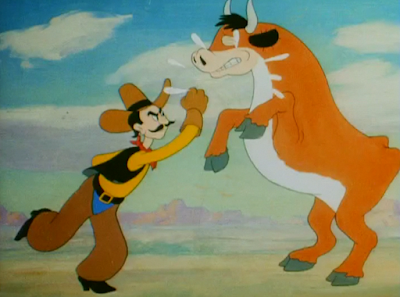




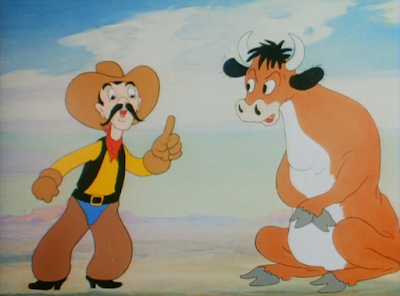
































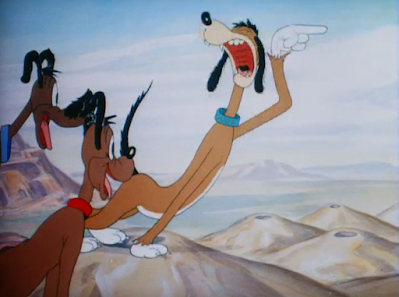

















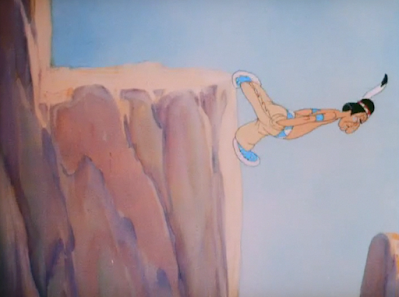
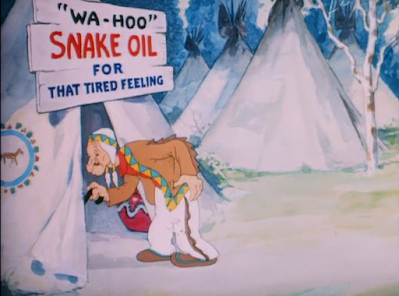






























No comments:
Post a Comment